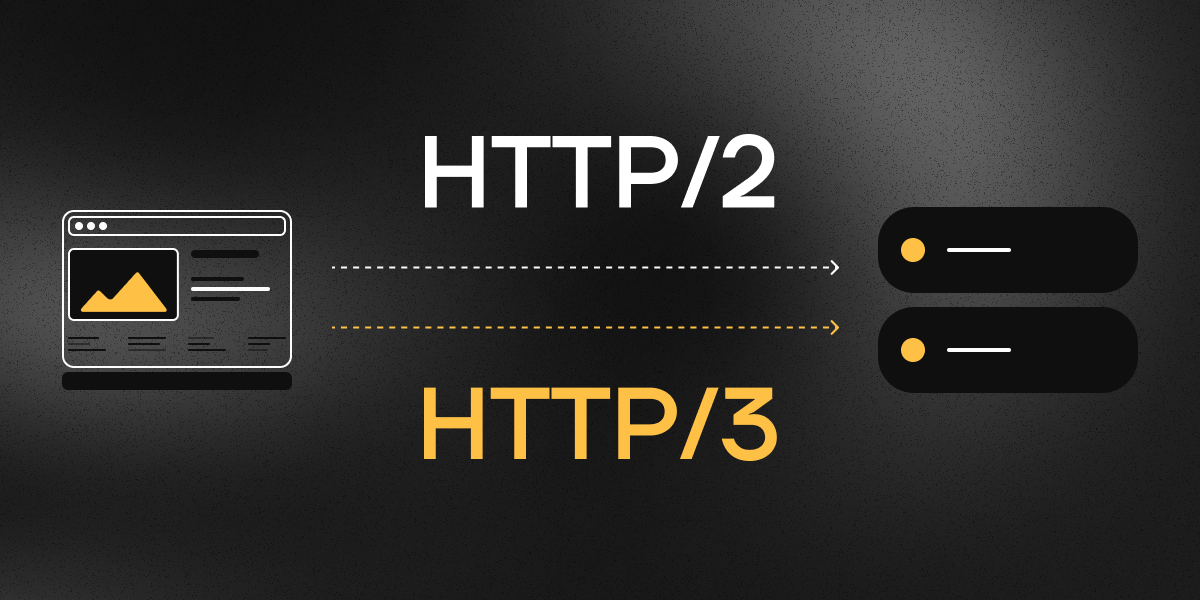HTTP/2 and HTTP/3: Faster, but Is It worth enabling them? Pros, cons, and configuration

Modern HTTP/2 and HTTP/3 protocols can significantly speed up site loading, improve user experience and increase search engine rankings. But not everything is so simple: they have both advantages and disadvantages. Let's understand what these protocols are, their pros and cons, and how to enable them on your server.
What are HTTP/2 and HTTP/3?
HTTP/2 is an updated version of the HTTP/1.1 protocol that allows multiple website resources to be loaded in parallel rather than one by one. This speeds up response times and reduces server load.
HTTP/3 is an even more advanced version that uses the QUIC protocol on top of UDP. It creates more stable connections, especially in poor network conditions.
Advantages
- HTTP/2
- Parallel (multiplexed) loading of site resources.
- Reduced latency through header compression.
- Traffic savings.
- HTTP/3
- Quick connection establishment with minimal delay.
- Resilience to packet loss (especially important for mobile internet).
- Excellent performance on unstable networks.
By enabling these protocols, you will speed up your site, make it more user-friendly, and gain an SEO advantage.
Disadvantages
- Compatibility
- HTTP/2 and HTTP/3 are not supported by older browsers and devices. For example, certain Internet Explorer versions and older Android devices cannot take advantage of these protocols.
- HTTP/3 depends on UDP, which can be blocked by some firewalls and network filters.
- Configuration complexity
- Incorrect configuration of HTTP/2 can worsen performance (for example, if stream prioritization is not used).
- HTTP/3 requires an up-to-date version of Nginx, OpenSSL, and QUIC support, which can be challenging on older servers.
- Resource consumption
- HTTP/3 is more demanding on server resources, particularly with a large number of connections.
- Dependence on HTTPS
- HTTP/2 only works over HTTPS, which increases the complexity and cost of certificate setup and maintenance.
5. HTTP/1.1 and performance with HTTP/2/3
- HTTP/2 and HTTP/3 do not exclude support for HTTP/1.1. This may slightly reduce performance, but it does not cause critical issues, since HTTP/1.1 is used only for clients that do not support more modern protocols.
How to Enable HTTP/2 and HTTP/3 in Nginx
If you are using a control panel, for example FASTPANEL, you can enable HTTP/2 and HTTP/3 for your site in the site settings without manually editing its configuration file.
- Checking compatibility
Connect to your server via SSH.
Check the current Nginx version:
sudo nginx -v
For HTTP/3, version 1.25.0 or higher is required.
Check the current OpenSSL version:
openssl version
To work with HTTP/3, you need OpenSSL version 3.0.0 or higher, as earlier versions do not support QUIC.
Additionally, before making changes to the nginx configuration, make sure there are no errors:
nginx -t
If everything is fine (you can ignore “warn” messages), you will see:
nginx: the configuration file /etc/nginx/nginx.conf syntax is ok
nginx: configuration file /etc/nginx/nginx.conf test is successful
2. Configure HTTP/2
Open your site’s configuration file in a text editor:
sudo nano /etc/nginx/sites-available/your-site.conf
Add the directive http2 to the listen 443 ssl line and add the line http2 on inside the server block, so it looks something like this:
server {
listen 443 ssl http2;
server_name example.com;
ssl_certificate /path/to/fullchain.pem;
ssl_certificate_key /path/to/privkey.pem;
http2 on;
rest of your config file
}
Note that a valid SSL certificate is required for HTTPS and HTTP/2 to function.
Restart the web server to apply the changes:
systemctl restart nginx
- Configure HTTP/3
Similarly to the previous step, open your site’s configuration file and modify it to look like this:
server {
listen 443 ssl http2;
listen 443 quic reuseport;
server_name example.com;
ssl_certificate /path/to/fullchain.pem;
ssl_certificate_key /path/to/privkey.pem;
http2 on;
ssl_protocols TLSv1.1 TLSv1.2 TLSv1.3;
add_header Alt-Svc 'h3=":443"; ma=86400';
rest of your config file
}
Here:
listen 443 quic reuseport;— enables HTTP/3 (QUIC) on port 443 and improves performance under high connection loads.ssl_protocols TLSv1.1 TLSv1.2 TLSv1.3;— specifies TLS versions for encryption. For better security, it’s recommended to use only TLSv1.2 and TLSv1.3.add_header Alt-Svc 'h3=":443"; ma=86400';— this header tells browsers that the server supports HTTP/3 and stores this information for 24 hours.
The parameter reuseport can only be used once in the Nginx server configuration. Attempting to specify it multiple times for different listen directives will cause conflicts and improper server operation.
Then run an additional compatibility check for your nginx version with these directives, as well as a syntax check:
nginx -t
If everything is fine (you can ignore “warn” messages), you will see:
nginx: the configuration file /etc/nginx/nginx.conf syntax is ok
nginx: configuration file /etc/nginx/nginx.conf test is successful
Restart Nginx to apply the changes:
systemctl restart nginx
Conclusion
HTTP/2 and HTTP/3 are a step into the future, speeding up site load times, improving SEO and making your resource more usable. However, it is important to consider compatibility, resource consumption and configuration complexity.
If most of your users are on modern browsers, start by enabling HTTP/2. Then move on to HTTP/3 if you’re ready to update your server software and are confident in your infrastructure’s compatibility.
If you prefer not to configure these protocols manually, you can choose a server with the free FASTPANEL, where enabling HTTP/2 and HTTP/3 for your site is simple and convenient.